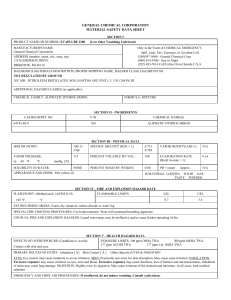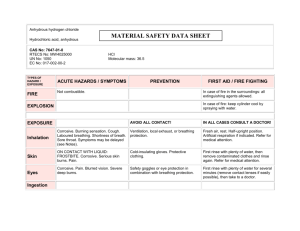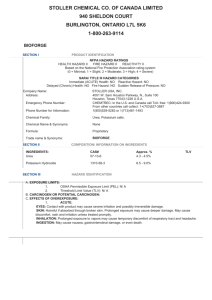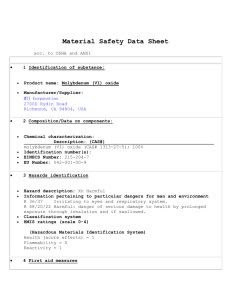MATERIAL SAFETY DATA SHEET PHOSPHORUS TRICHLORIDE 1
advertisement
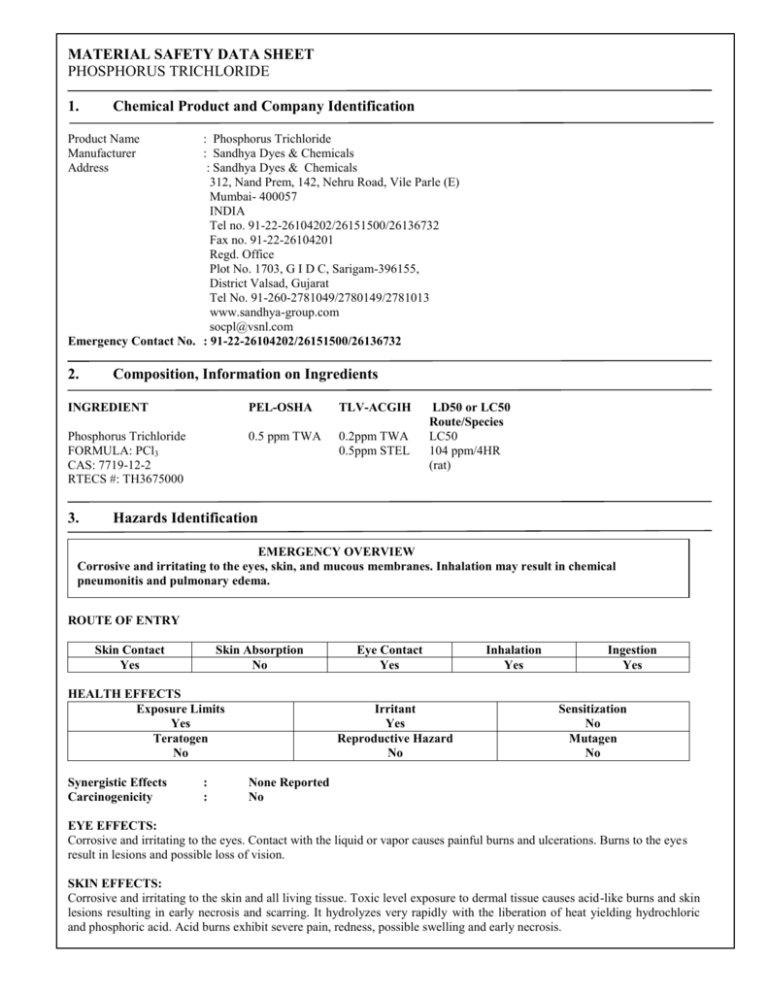
MATERIAL SAFETY DATA SHEET PHOSPHORUS TRICHLORIDE 1. Chemical Product and Company Identification Product Name Manufacturer Address : Phosphorus Trichloride : Sandhya Dyes & Chemicals : Sandhya Dyes & Chemicals 312, Nand Prem, 142, Nehru Road, Vile Parle (E) Mumbai- 400057 INDIA Tel no. 91-22-26104202/26151500/26136732 Fax no. 91-22-26104201 Regd. Office Plot No. 1703, G I D C, Sarigam-396155, District Valsad, Gujarat Tel No. 91-260-2781049/2780149/2781013 www.sandhya-group.com socpl@vsnl.com Emergency Contact No. : 91-22-26104202/26151500/26136732 2. Composition, Information on Ingredients INGREDIENT PEL-OSHA TLV-ACGIH Phosphorus Trichloride FORMULA: PCl3 CAS: 7719-12-2 RTECS #: TH3675000 0.5 ppm TWA 0.2ppm TWA 0.5ppm STEL 3. LD50 or LC50 Route/Species LC50 104 ppm/4HR (rat) Hazards Identification EMERGENCY OVERVIEW Corrosive and irritating to the eyes, skin, and mucous membranes. Inhalation may result in chemical pneumonitis and pulmonary edema. ROUTE OF ENTRY Skin Contact Yes Skin Absorption No HEALTH EFFECTS Exposure Limits Yes Teratogen No Synergistic Effects Carcinogenicity : : Eye Contact Yes Irritant Yes Reproductive Hazard No Inhalation Yes Ingestion Yes Sensitization No Mutagen No None Reported No EYE EFFECTS: Corrosive and irritating to the eyes. Contact with the liquid or vapor causes painful burns and ulcerations. Burns to the eyes result in lesions and possible loss of vision. SKIN EFFECTS: Corrosive and irritating to the skin and all living tissue. Toxic level exposure to dermal tissue causes acid-like burns and skin lesions resulting in early necrosis and scarring. It hydrolyzes very rapidly with the liberation of heat yielding hydrochloric and phosphoric acid. Acid burns exhibit severe pain, redness, possible swelling and early necrosis. MATERIAL SAFETY DATA SHEET PHOSPHORUS TRICHLORIDE INGESTION EFFECTS: None specified. INHALATION EFFECTS: Corrosive and irritating to the upper and lower respiratory tract and all mucosal tissue. Symptoms include lacrimation, cough, labored breathing, and excessive salivary and sputum formation. Excessive irritation causes chemical pneumonitis and pulmonary edema which could be fatal. NFPA HAZARD CODES Health: 4 Flammability: 0 Reactivity: 2 WATER REACTIVE 4. HMIS HAZARD CODES Health: 3 Flammability: 0 Reactivity: 2 RATINGS SYSTEM 0 No Hazard 1 Slight Hazard 2 Moderate Hazard 3 Serious Hazard 4 Severe Hazard First Aid Measures EYES: PERSONS WITH POTENTIAL EXPOSURE SHOULD NOT WEAR CONTACT LENSES. Flush contaminated eyes with copious quantities of water. Part eyelids to assure complete flushing. Continue for a minimum of 15 minutes. Seek immediate medical attention. SKIN: Remove contaminated clothing as rapidly as possible. Flush affected area with copious quantities of water. Seek immediate medical attention. INGESTION: Not specified. Seek immediate medical attention. INHALATION: PROMPT MEDICAL ATTENTION IS MANDATORY IN ALL CASES OF OVEREXPOSURE. RESCUE PERSONNEL SHOULD BE EQUIPPED WITH SELF-CONTAINED BREATHING APPARATUS. Victims should be assisted to an uncontaminated area and inhale fresh air. Quick removal from the contaminated area is most important. Unconscious persons should be moved to an uncontaminated area, and if breathing has stopped, administer artificial resuscitation and supplemental oxygen. Keep victim warm and quiet. Assure that mucus or vomited material does not obstruct the airway by use of positional drainage. Delayed pulmonary edema may occur. Keep patient under medical observation for at least 24 hours. 5. Fire Fighting Measures Conditions of Flammability : Nonflammable Flash point : None Method : None Autoignition Temperature : None LEL(%) : None UEL(%) : None Hazardous combustion products : None Sensitivity to mechanical shock : None Sensitivity to static discharge: None FIRE AND EXPLOSION HAZARDS : Reacts with water yielding HCl and Phosphoric acids. EXTINGUISHING MEDIA : Nonflammable FIRE FIGHTING INSTRUCTIONS : None. MATERIAL SAFETY DATA SHEET PHOSPHORUS TRICHLORIDE 6. Accidental Release Measures Evacuate all personnel from affected area. Use appropriate protective equipment. If leak is in user’s equipment, be certain to purge piping with inert gas prior to attempting repairs. If leak is in container or container valve, contact the appropriate emergency telephone number listed in Section 1 7. Handling and Storage Electrical classification : Non-hazardous. Use only in well-ventilated areas. Containers must remain closed unless they are being used. Do not drag, slide or roll cylinders. Use a suitable hand truck for container movement recognizing that the metal containers can easily be punctured and the glass containers or carboys are easily broken. Protect cylinders from physical damage. Store in cool, dry, wellventilated areas of non-combustible construction away from heavily trafficked areas and emergency exits. Cylinders should be stored upright and firmly secured to prevent falling or being knocked over. Full & empty cylinders should be segregated. Use a "first in-first out" inventory system to prevent full containers from being stored for excessive periods of time. Never carry a compressed gas cylinder or a container of a gas in cryogenic liquid form in an enclosed space such as a car trunk, van or station wagon. A leak can result in a fire, explosion, asphyxiation or a toxic exposure. 8. Exposure Controls, Personal Protection EXPOSURE LIMITS: INGREDIENT Phosphorus Trichloride FORMULA: PCl3 CAS: 7719-12-2 RTECS #: TH3675000 PEL-OSHA TLV-ACGIH 0.5 ppm TWA 0.2ppm TWA 0.5ppm STEL LD50 or LC50 Route/Species LC50 104 ppm/4HR (rat) ENGINEERING CONTROLS: Hood with forced ventilation. Use local exhaust ventilation to prevent accumulation above the exposure limit. EYE/FACE PROTECTION: Safety goggles or glasses. SKIN PROTECTION: Neoprene or butyl rubber, PVC, or polyethylene gloves. RESPIRATORY PROTECTION: Positive pressure air line with full-face mask and escape bottle or self-contained breathing apparatus should be available for emergency use. OTHER/ GENERAL PROTECTION: Safety shoes, safety shower, eyewash "fountain", face shield. 9. Physical and Chemical Properties PARAMETER Physical state (gas, liquid, solid) Vapor pressure at STP Vapor density (Air = 1) Evaporation point : Not Available Boiling point Freezing point : pH VALUE : Liquid : 1.9 : Not Available UNITS : 168 : 75.5 : -170 : -112 : Not Available F C F C psia MATERIAL SAFETY DATA SHEET PHOSPHORUS TRICHLORIDE PARAMETER Specific gravity (H2O = 1) Oil/water partition coefficient Solubility (H20) Odor threshold Odor and appearance 10. VALUE : 1.574 : Not Available : Reacts violently : Not Available : Pungent odor; Colorless, fuming liquid. Stability and Reactivity STABILITY INCOMPATIBLE MATERIALS HAZARDOUS DECOMPOSITION PRODUCTS HAZARDOUS POLYMERIZATION 11. : : : : Stable. Water and water vapor. In water, reacts violently. Hydrochloric and phosphoric acid upon hydrolysis. Will not occur. Toxicological Information LC50 (Rat) - Inhalation of 104 ppm/4H. 12. Ecological Information No data given. 13. Disposal Considerations Do not attempt to dispose of residual waste or unused quantities. 14. Transport Information PROPER SHIPPING NAME HAZARD CLASS SUBSIDARY RISK IDENTIFICATION NUMBER SHIPPING LABEL Packing Group 15. : Phosphorus Trichloride : 6.1 :8 : UN 1809 : TOXIC :I Regulatory Information Symbol 16. UNITS Other Information -
